Lau chingri aka lau chingri recipe Bengali is a Bengali delicacy and one of the most popular traditional Bengali food. It is known for its subtle taste, texture and unbeatable flavour. Lau chingri recipe is a pure comfort dish which is frequently prepared in almost every Bengali house. In this preparation, bottle gourd aka lau is cooked with fried chingri mach aka prawns in minimal spices. It is mostly relished as a side with hot steamed rice.
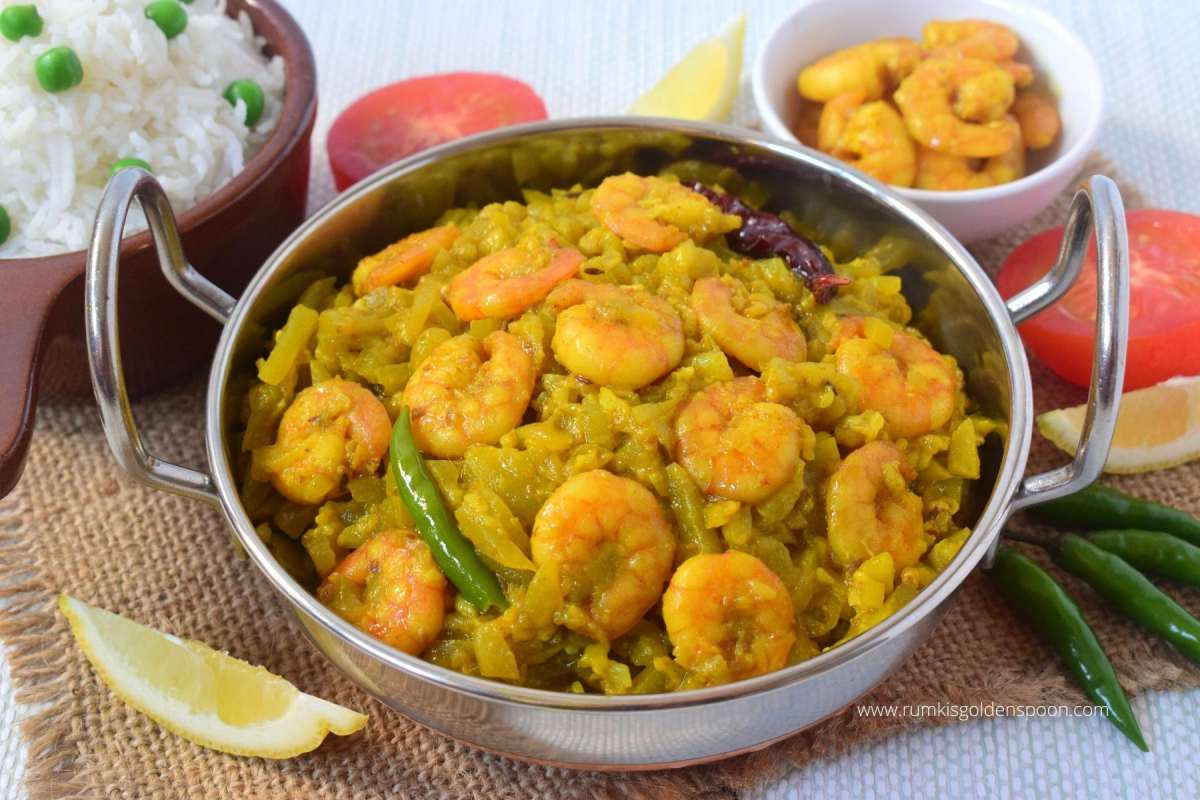
Table of Contents
About the recipe
Health Benefits of bottle gourd
How to make Lau chingri (step wise photos)
Recipe Card
What is Lau chingri?
Lau chingri is a classic delight and the name of the recipe itself explains the dish. It is a Bengali name and the word ‘Lau’ stands for bottle gourd and ‘chingri’ means prawn. Basically, lau chingri recipe is a Bengali speciality in which vegetables are cut into small length wise thin strips and cooked as a dry curry aka mishmash with prawns.
Bengalis have an eternal relationship with fish and there is no doubt about it. Addition of fish with vegetables in curries is one of their forte to make the boring vegetables exciting and yummier. Bengalis frequently add small fishes, prawns and fish head in different vegetable curries. Lau chingri is one of the finest examples of these recipes.
Lau chingri recipe is one of the most popular topics among Bangal (O par bangla) and Ghoti (Epar bangla people) affair. In a funny note, Ghotis claim that they are connected to chingri mach aka prawns and bangals claim that they are connected to ilish mach aka hilsa fish. Other than this, lau chingri is also mentioned in one of the popular stories of Gopal Bhar where he added fried prawns into the Lau ghonto in his widow pishi’s meal and it turned into Lau chingri.
Lau chingri recipe bengali is one of my favourites since childhood. I know bottle gourd is considered as one of the most boring vegetables which children do not even want to try. But this lau chingri recipe can completely change your kids’ point of view towards bottle gourd and can become one of their favourites.
A bowl of lau chingri with plain rice, dal and jhuri aloo bhaja is just like a bliss which only a bong can imagine. I am pretty sure many people are in the same side with me. If you have never tried it then I recommend you try it at least once.
I still remember whenever my dad bought bottle gourd from the market, he always made sure to buy prawns too and asked my mom to prepare lau chingri. I have eaten this delight hundreds of times but never got bored of it. I have learnt even this authentic Bengali recipe from my mom.
Lau chingri is a very lite and healthy recipe where you would require minimal spices to prepare it. From kids to elders, this recipe is suitable for everyone and it could be a healthy and delectable addition to your regular diet. This amish aka non vegetarian lau ghonto is a pure Bengali delicacy and you will get the essence of Bengal in it.
Lau chingri recipe bengali is a very simple and easy recipe. The difficulty level of cooking the dish is low and can be suitable for a novice. It requires very limited ingredients which are easily available in any Bengali kitchen pantry. Other than regular meal, it could be a perfect side for any occasion like marriage ceremony, annaprasan and family get togethers.
Lau chingri with step by step photos and instructions have been provided in the ‘Instructions’ section of the recipe. If you follow my recipe precisely then you will get the perfect lau chingri recipe on your plate. But before directly jumping into the recipe, let me share few interesting facts about the primary ingredient of the recipe ‘Lau’ aka ‘Bottle gourd’ and the recipe.
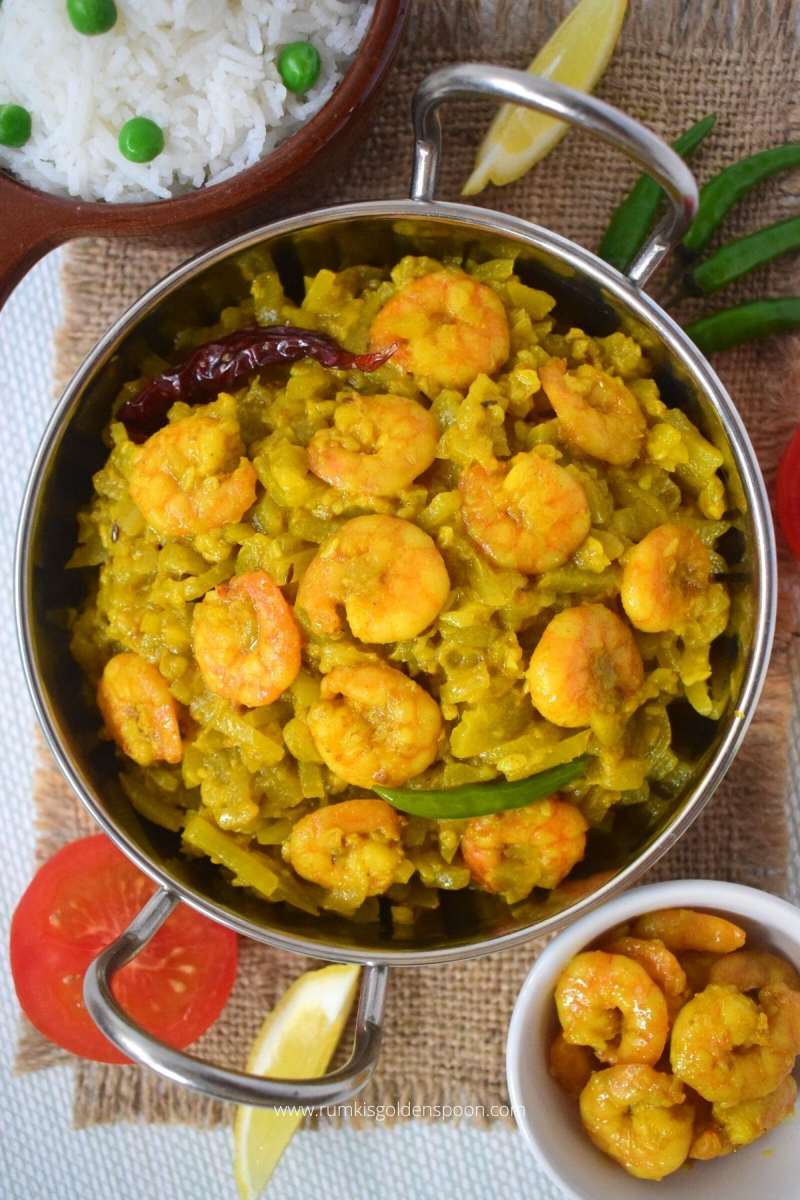
Health benefits of bottle gourd
- Bottle gourd is very low in fat and cholesterol which is good for weight loss.
- Bottle gourd is full of dietary fibre which is good for the digestive system and helps to get rid of piles, constipation etc.
- It is full of nutrients and vitamins which are good for nourishing the body.
- It is full of potassium and sodium which helps to regulate the blood pressure and is good for the heart health as well.
- It is a good source of iron and is full of antioxidants.
- Bottle gourd is full of water (approximately 96%) which helps the body to cool down.
Reason for popularity of Lau chingri
- Lau chingri recipe is easy to make and gets prepared without much hustle.
- It is a very healthy and lite dish prepared using minimal spices.
- It is undoubtedly the best way to make your kids eat bottle gourd.
- Though it is a non-vegetarian recipe but still it’s a no onion no garlic recipe which is preferred by many people.
How to cut bottle gourd for Lau ghonto?
Bengalis are very particular about cutting vegetables for different types of dishes. For each of chorchori, dalna, ghonto preparations, they cut the vegetables differently in a specific way.
For any ghonto preparation, Bengalis cut the vegetables into small and thin strips like match sticks.
First take a large bowl of water and then peel the bottle gourd and cut them into halves, both in vertical and horizontal direction. Cut each portion into thin slices like semi circles. Then gather few semi-circular pieces and cut them into thin strips in vertical direction. Gather the strips and put them into the large bowl of water. Repeat the process and cut the complete bottle gourd and wash the pieces nicely.
How to make Lau chingri?
To prepare the lau chingri, first cut the bottle gourd into thin small strips and wash them once. Then drain the water and keep them aside.
On the other hand, clean and wash the prawns. Then marinate them with salt and turmeric powder for at least 10 minutes and keep it aside.
On the other hand, put a pan on flame and add mustard oil into it. Usage of mustard oil enhances the flavour and taste of the dish. Once the oil is hot, add the marinated prawns into the pan and fry them in low flame for some time. Don’t over fry the prawns or else it will become rubbery. Keep them aside on a separate plate.
In the same pan, add oil if required and add dry red chilli, bay leaf and cumin seeds into the pan for tempering and let them crackle.
Then add the bottle gourd pieces into the pan and give a nice stir. Cook it over medium flame for 5 minutes. Add ginger paste into the pan and mix it well. Cook it in low flame for 2-3 minutes until the raw smell of ginger goes away.
After this, add salt, turmeric powder, red chilli powder and mix them nicely. Cover the pan and cook it in low flame for approximately 20 minutes until the bottle gourd gets cooked completely in its own juice. Add green chillies in between after 10 minutes. Stir in between, once or twice. Lau ghonto is a slow cooking recipe and it tastes great when cooked in low flame.
Take off the lid of the pan and give a stir. Then add cumin powder, sugar and mix it well. Cook it in low flame for another couple of minutes.
Add the fried prawns at this stage and mix it well. Cover the pan and cook it in low flame for another 5 minutes and then switch off the flame.
Many traditional Bengali Recipes have already been shared in my previous posts. You can check few of them like
Daler bori diye lau ghonto
Echor chingri
Chanar Dalna
Aloo Posto
..And Many more…

Ingredients:
To marinate the prawn
- 250 grams Prawn (Chingri)
- ½ teaspoon Salt
- ½ teaspoon Turmeric powder
Other ingredients for Lau chingri
- 1 kg Bottle gourd (Lau), peeled and cut into thin strips
- ½ teaspoon Ginger paste
- 2-3 green Chillies
- ½ teaspoon Cumin seeds (Jeera)
- 2 dry red Chilli (Shukno lanka)
- 1 Bay leaf (Tejpatta)
- ½ teaspoon Turmeric powder
- ½ teaspoon red Chilli powder
- ½ teaspoon Cumin powder
- 2 teaspoons Sugar (Adjust accordingly)
- Salt to taste
- 2 tablespoons Mustard oil
Instructions:
- Peel the bottle gourd and cut them into four pieces. Then cut them into thin small strips.
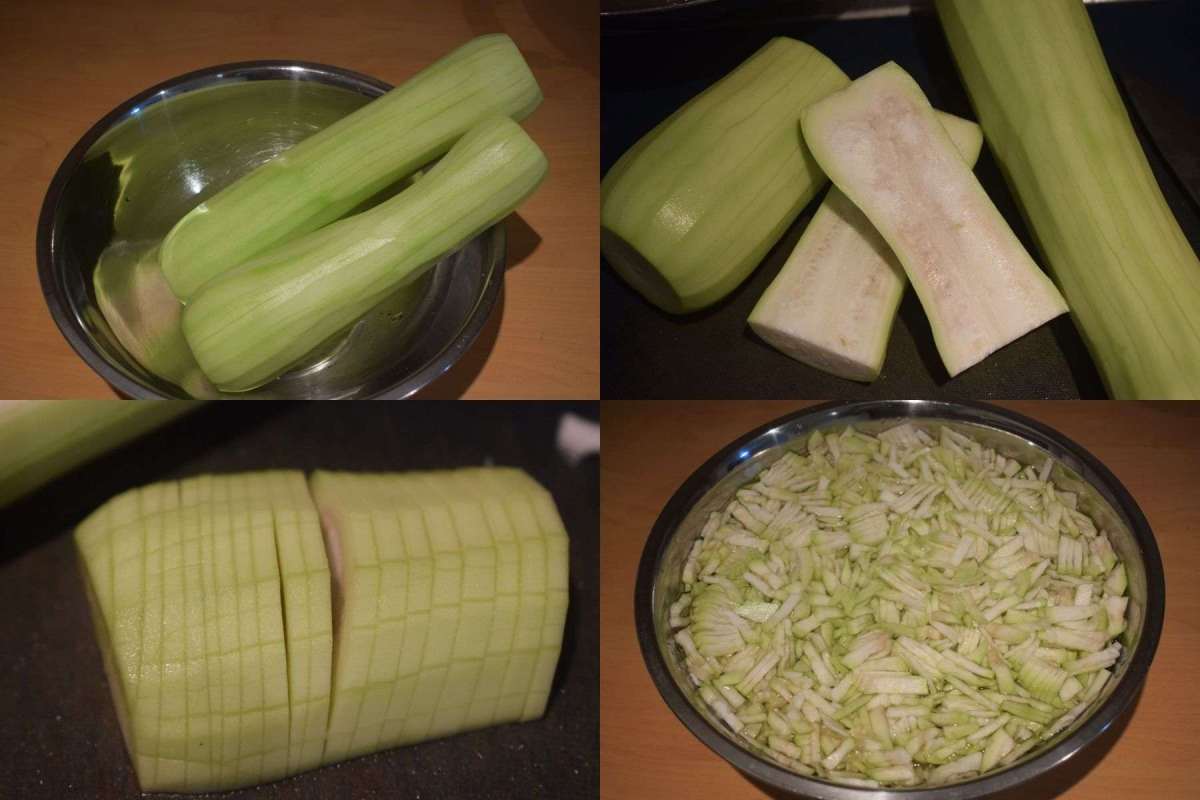
- Wash them once and then strain them properly. Keep it aside.
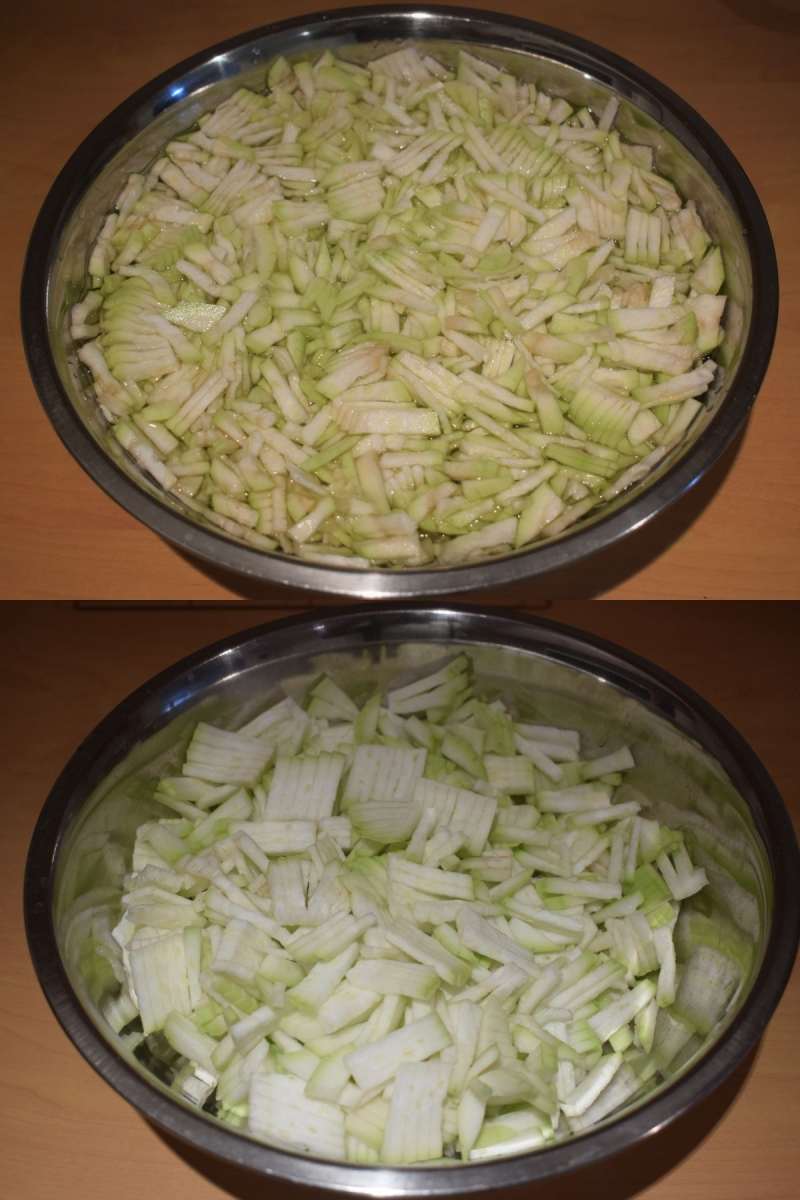
- Cut and clean the prawns and wash them nicely. Marinate the prawns with ½ teaspoon salt and ½ teaspoon turmeric powder and keep them aside for at least 10 minutes.
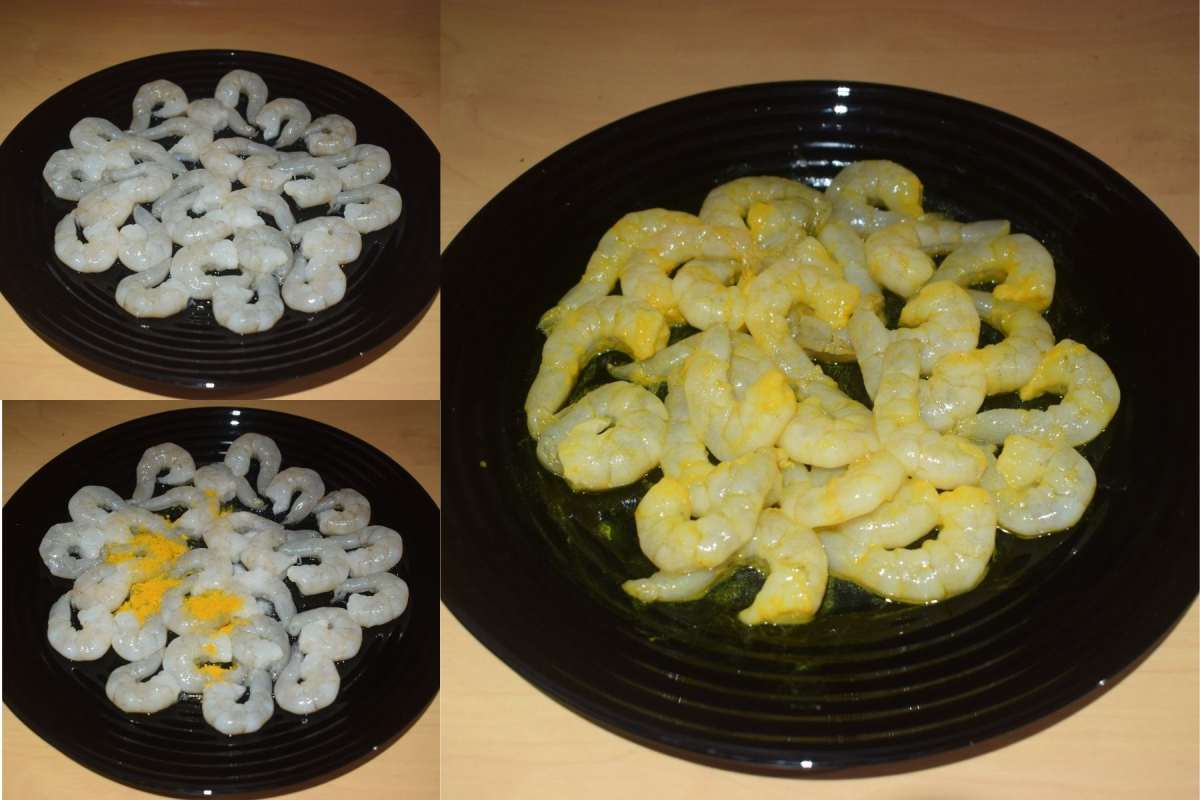
- On the other hand, put a pan on flame and allow it to become completely dry. Add 2 tablespoons of mustard oil into it and wait until it is hot.
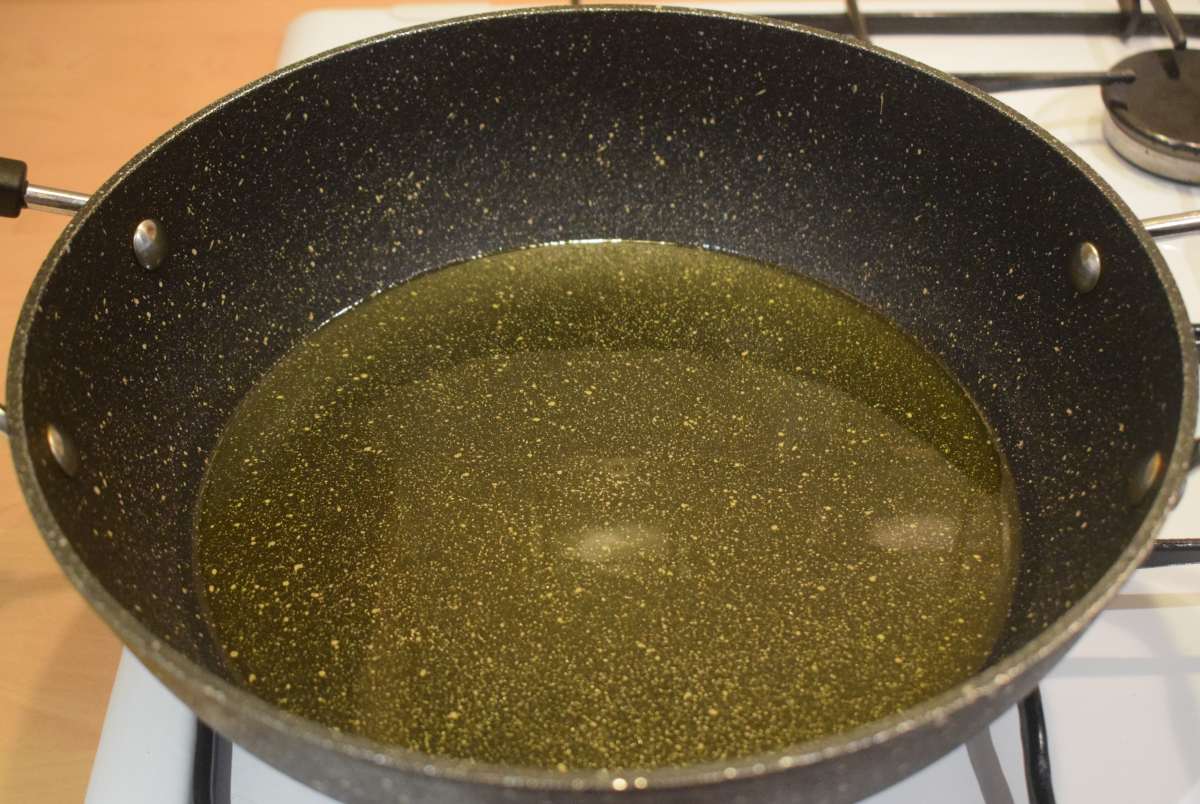
- Once the oil is hot, add the marinated prawns (Step 3) and fry them in low flame for 2 minutes. Turn the prawns and cook the other side in low flame for another 2 minutes. Transfer the fried prawns on a plate and keep it aside.
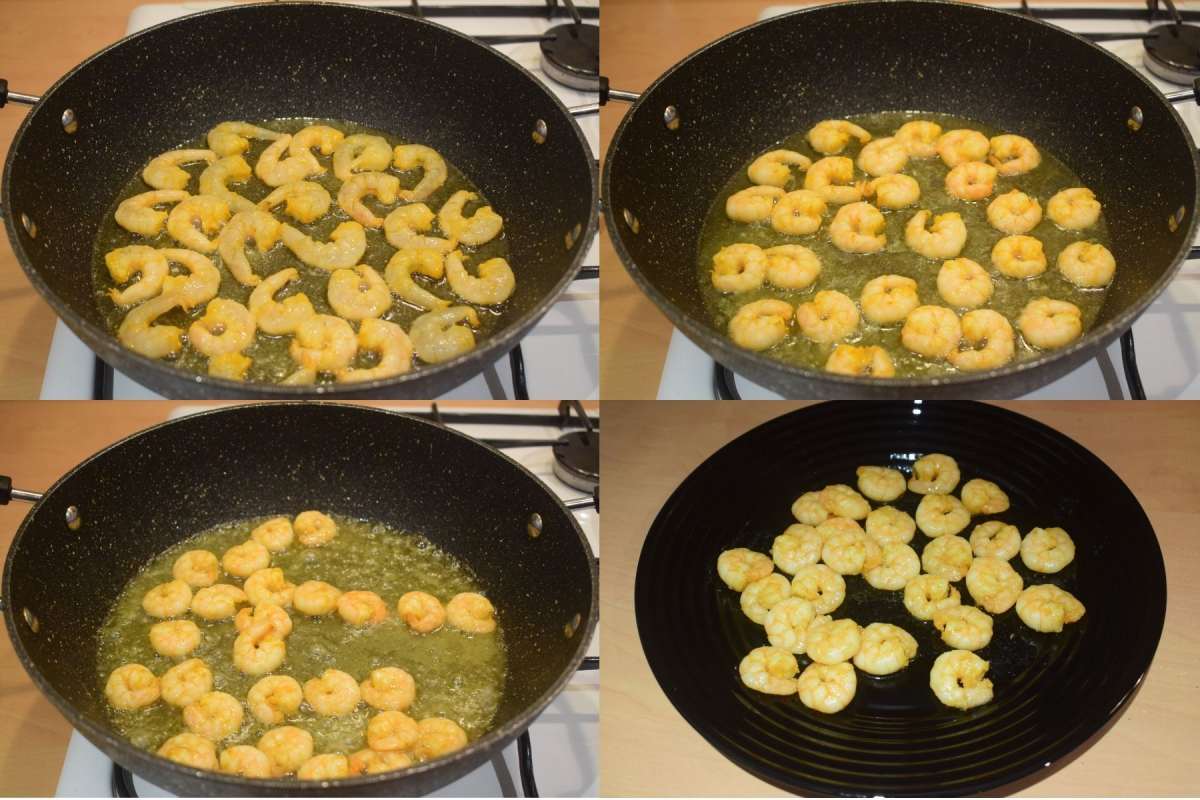
Note: Don’t over fry the prawns or else it will become rubbery. - In the same pan, add 2 dry red chillies, 1 bay leaf and ½ teaspoon cumin seeds into the pan for tempering and let them crackle.
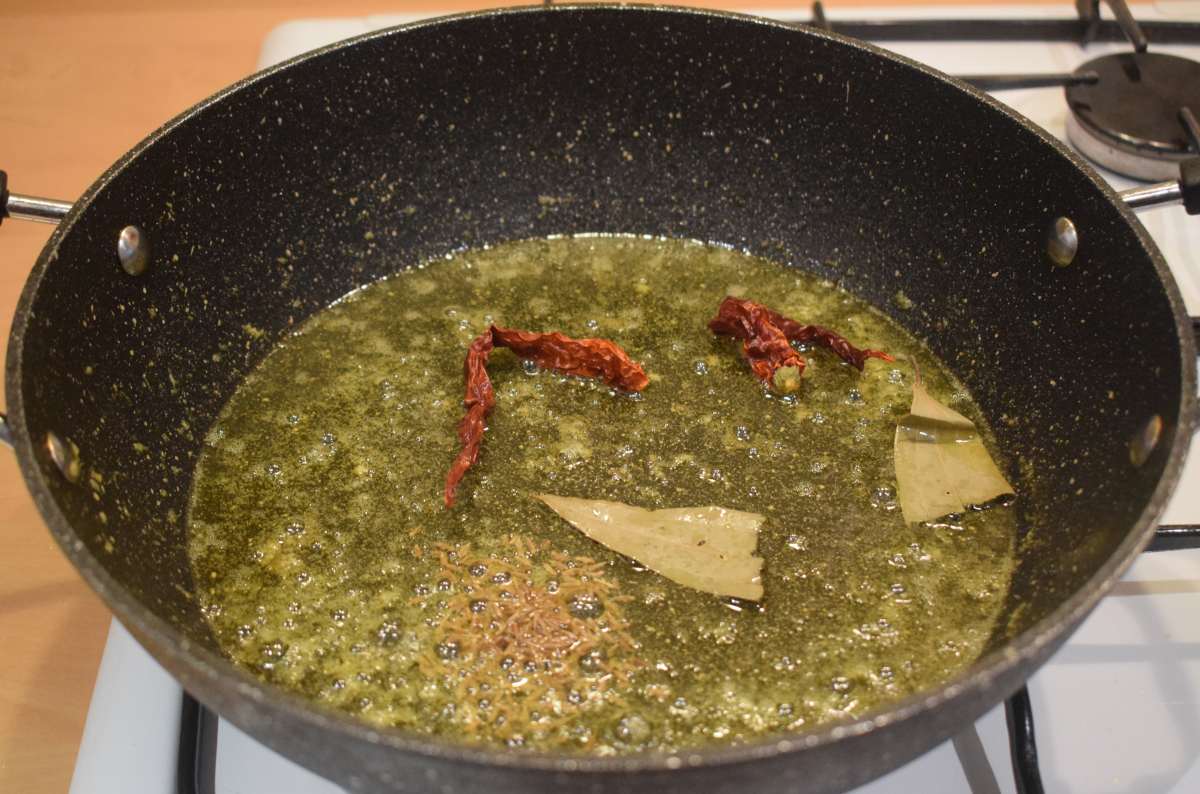
- Add the bottle gourd pieces (Step 2) into the pan and give a nice stir. Cook it over medium flame for 5 minutes.
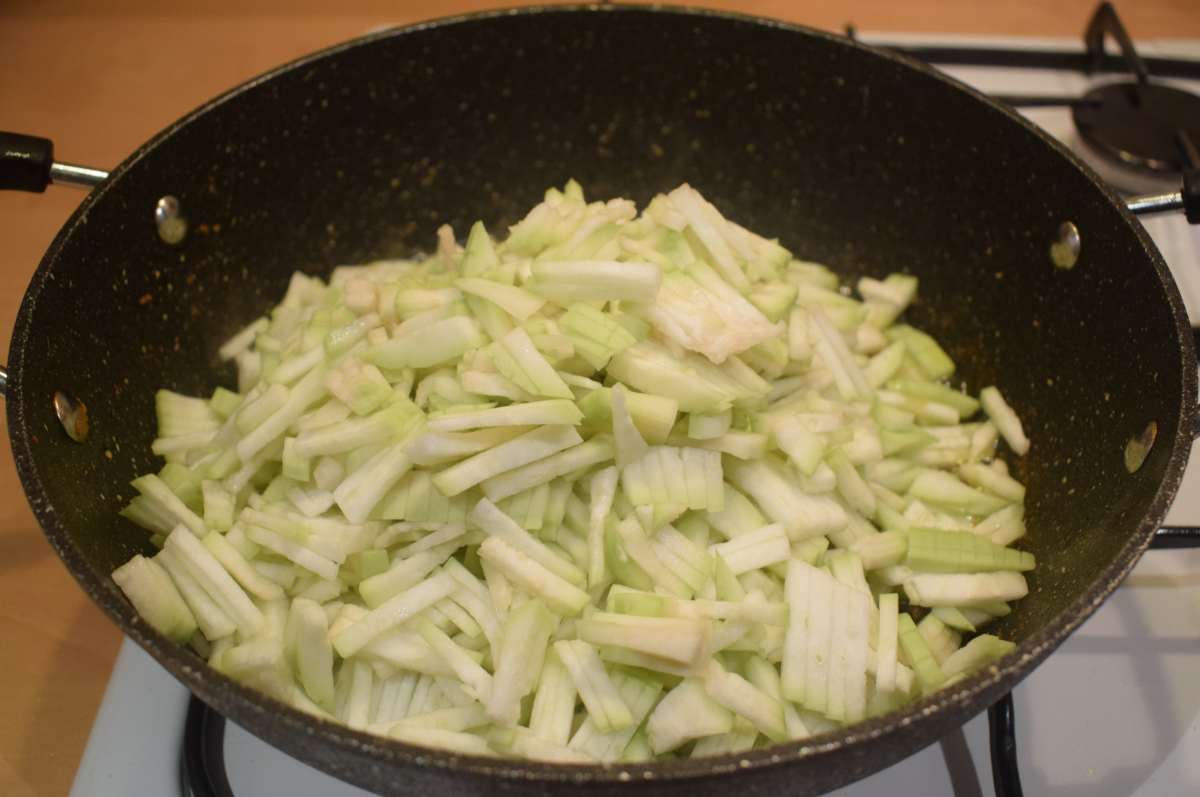
- Add ½ teaspoon ginger paste into the pan and mix it well. Cook it in low flame for 2-3 minutes until the raw smell of ginger goes away.
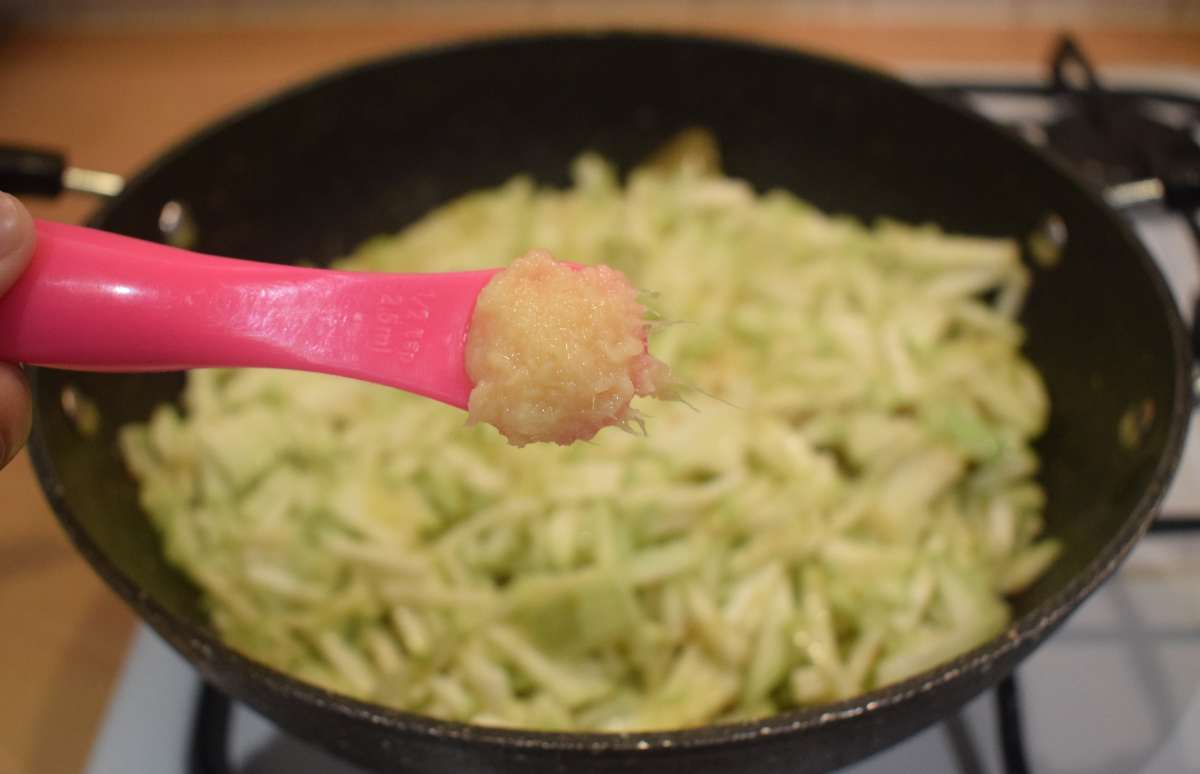
- Add salt, ½ teaspoon turmeric powder, ½ teaspoon red chilli powder into the pan and mix it nicely. Cover the pan and cook it in low flame for approximately 10 minutes.
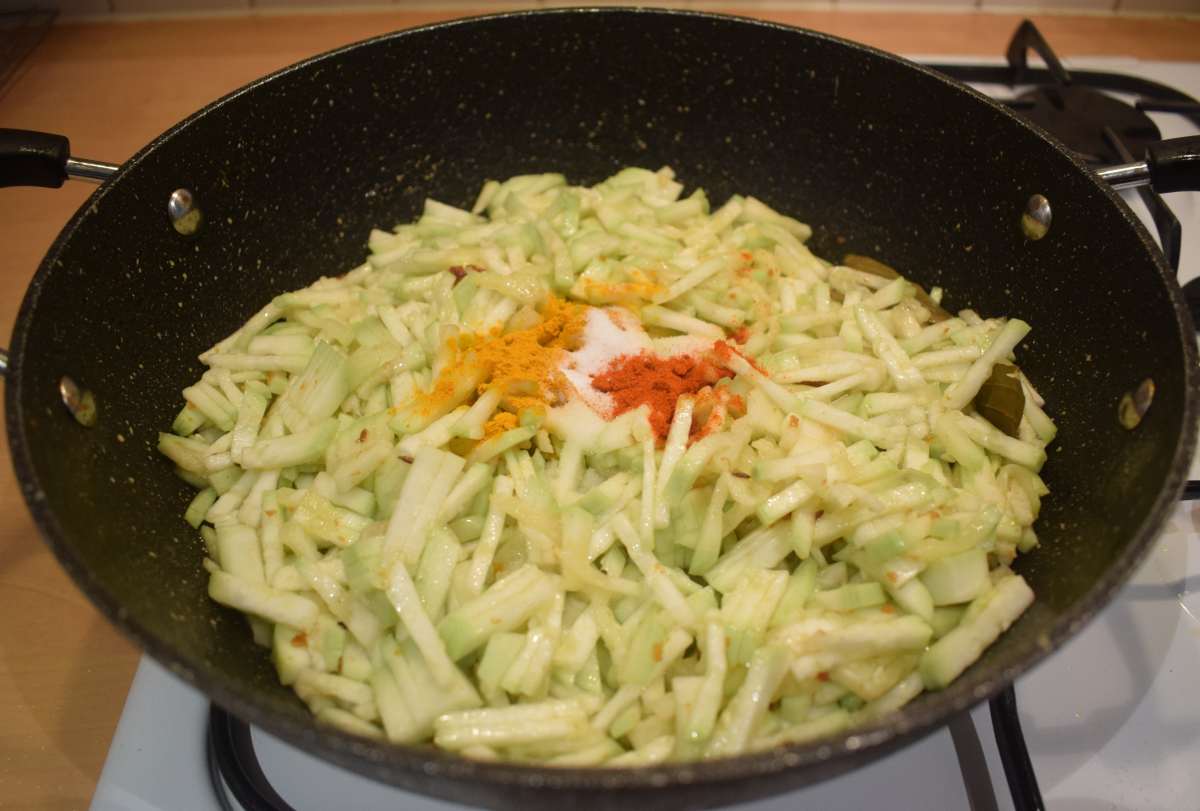
- Take off the lid and add 2-3 green chillies and mix it. Again, cover the pan and cook it for another 10-12 minutes until the bottle gourd gets cooked completely in its own juice. Stir in between once.

- Take off the lid of the pan and give a stir. Then add ½ teaspoon cumin powder, sugar and mix it well. Cover the pan and cook it in low flame for another couple of minutes.
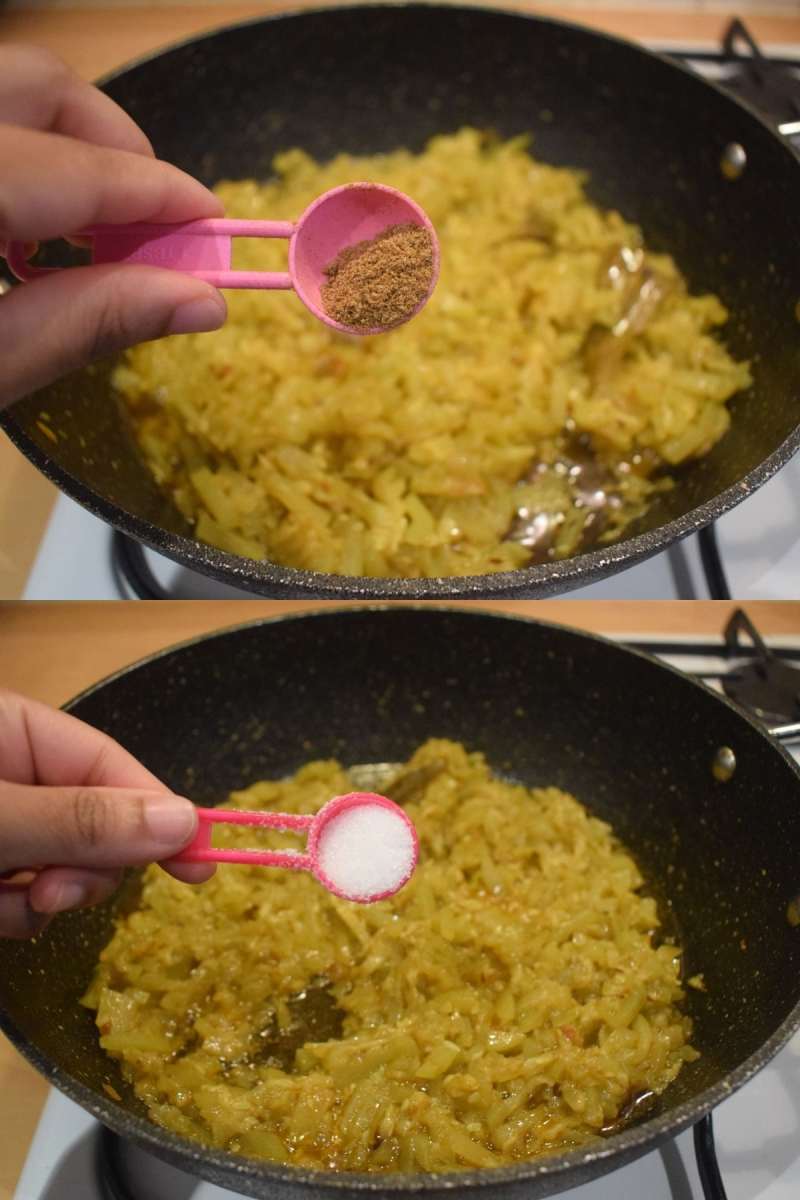
- Add the fried prawns (Step 5) at this stage and mix it well. Cover the pan and cook it in low flame for another 5 minutes.
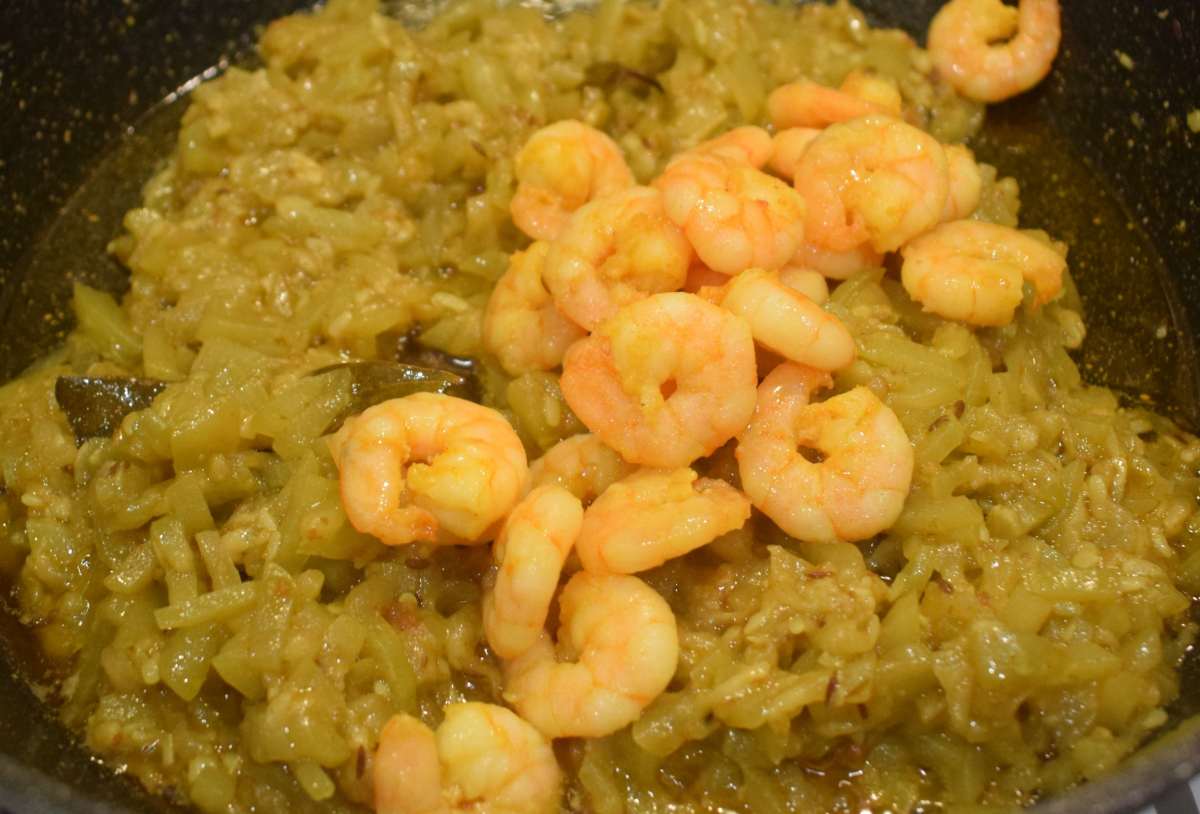
- Switch off the flame and put the pan down.

Serving Instruction
Transfer the lau chingri recipe into a serving bowl. Serve hot or warm with Plain Rice and Dal and enjoy the comforting meal of Bengal.
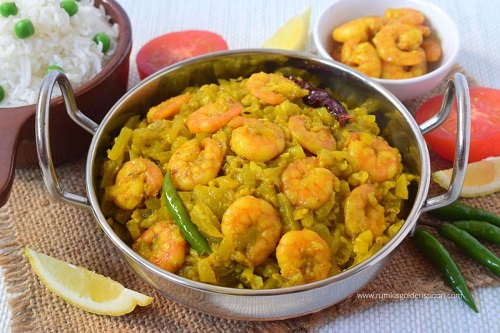
Ingredients
To marinate the prawn
- 250 grams Prawn (Chingri)
- ½ teaspoon Salt
- ½ teaspoon Turmeric powder
Other ingredients for Lau chingri
- 1 kg Bottle gourd (Lau), peeled and cut into thin strips
- ½ teaspoon Ginger paste
- 2-3 green Chillies
- ½ teaspoon Cumin seeds (Jeera)
- 2 dry red Chilli (Shukno lanka)
- 1 Bay leaf (Tejpatta)
- ½ teaspoon Turmeric powder
- ½ teaspoon red Chilli powder
- ½ teaspoon Cumin powder
- 2 teaspoons Sugar (Adjust accordingly)
- Salt to taste
- 2 tablespoons Mustard oil
Instructions
- Peel the bottle gourd and cut them into four pieces. Then cut them into thin small strips.
- Wash them once and then strain them properly. Keep it aside.
- Cut and clean the prawns and wash them nicely. Marinate the prawns with ½ teaspoon salt and ½ teaspoon turmeric powder and keep them aside for at least 10 minutes.
- On the other hand, put a pan on flame and allow it to become completely dry. Add 2 tablespoons of mustard oil into it and wait until it is hot.
- Once the oil is hot, add the marinated prawns (Step 3) and fry them in low flame for 2 minutes. Turn the prawns and cook the other side in low flame for another 2 minutes. Transfer the fried prawns on a plate and keep it aside.
Note: Don’t over fry the prawns or else it will become rubbery.
- In the same pan, add 2 dry red chillies, 1 bay leaf and ½ teaspoon cumin seeds into the pan for tempering and let them crackle.
- Add the bottle gourd pieces (Step 2) into the pan and give a nice stir. Cook it over medium flame for 5 minutes.
- Add ½ teaspoon ginger paste into the pan and mix it well. Cook it in low flame for 2-3 minutes until the raw smell of ginger goes away.
- Add salt, ½ teaspoon turmeric powder, ½ teaspoon red chilli powder into the pan and mix it nicely. Cover the pan and cook it in low flame for approximately 10 minutes.
- Take off the lid and add 2-3 green chillies and mix it. Again, cover the pan and cook it for another 10-12 minutes until the bottle gourd gets cooked completely in its own juice. Stir in between once.
- Take off the lid of the pan and give a stir. Then add ½ teaspoon cumin powder, sugar and mix it well. Cover the pan and cook it in low flame for another couple of minutes.
- Add the fried prawns (Step 5) at this stage and mix it well. Cover the pan and cook it in low flame for another 5 minutes.
- Switch off the flame and put the pan down.

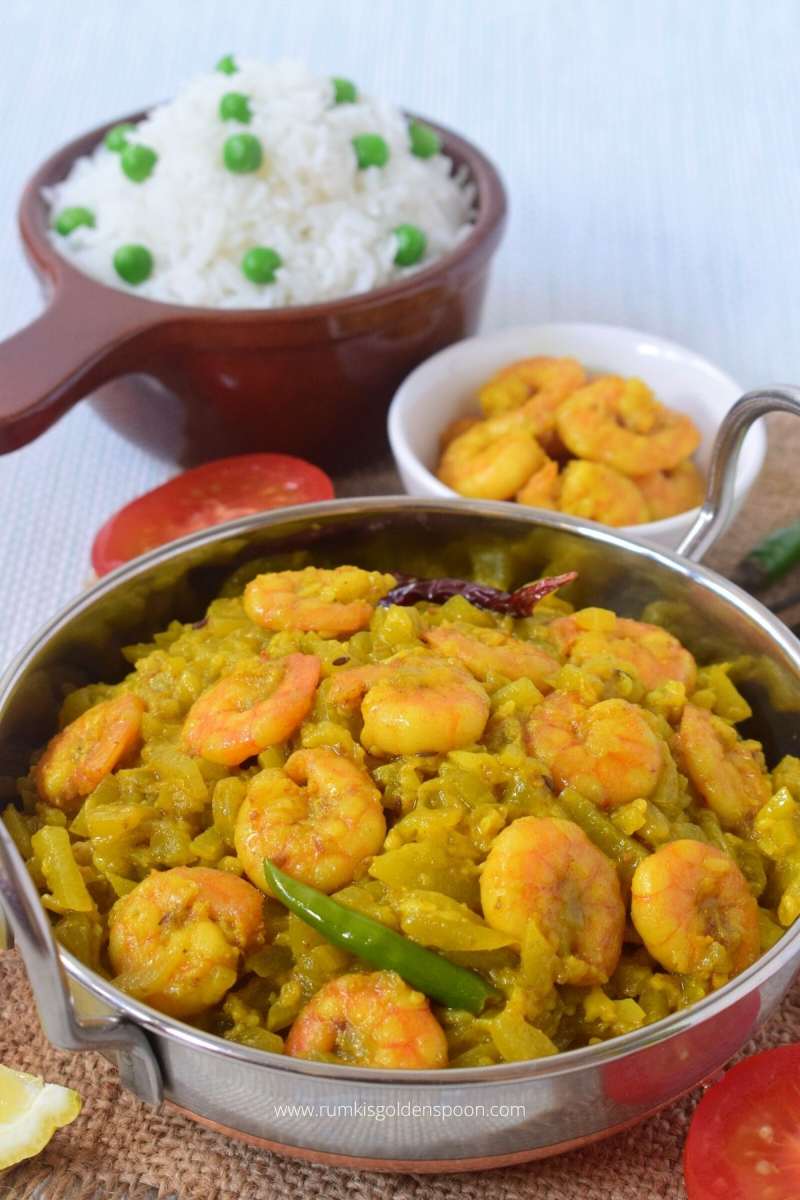
4 comments
[…] chingri Lau chingri Echor […]
[…] yummier. Bengalis frequently add small fish, prawns and fish heads in different vegetable curries. Lau chingri, macher matha diye begun, kumro chingri are the finest examples of […]
Thanks for the Lau chingri recipe.
You are Welcome!!